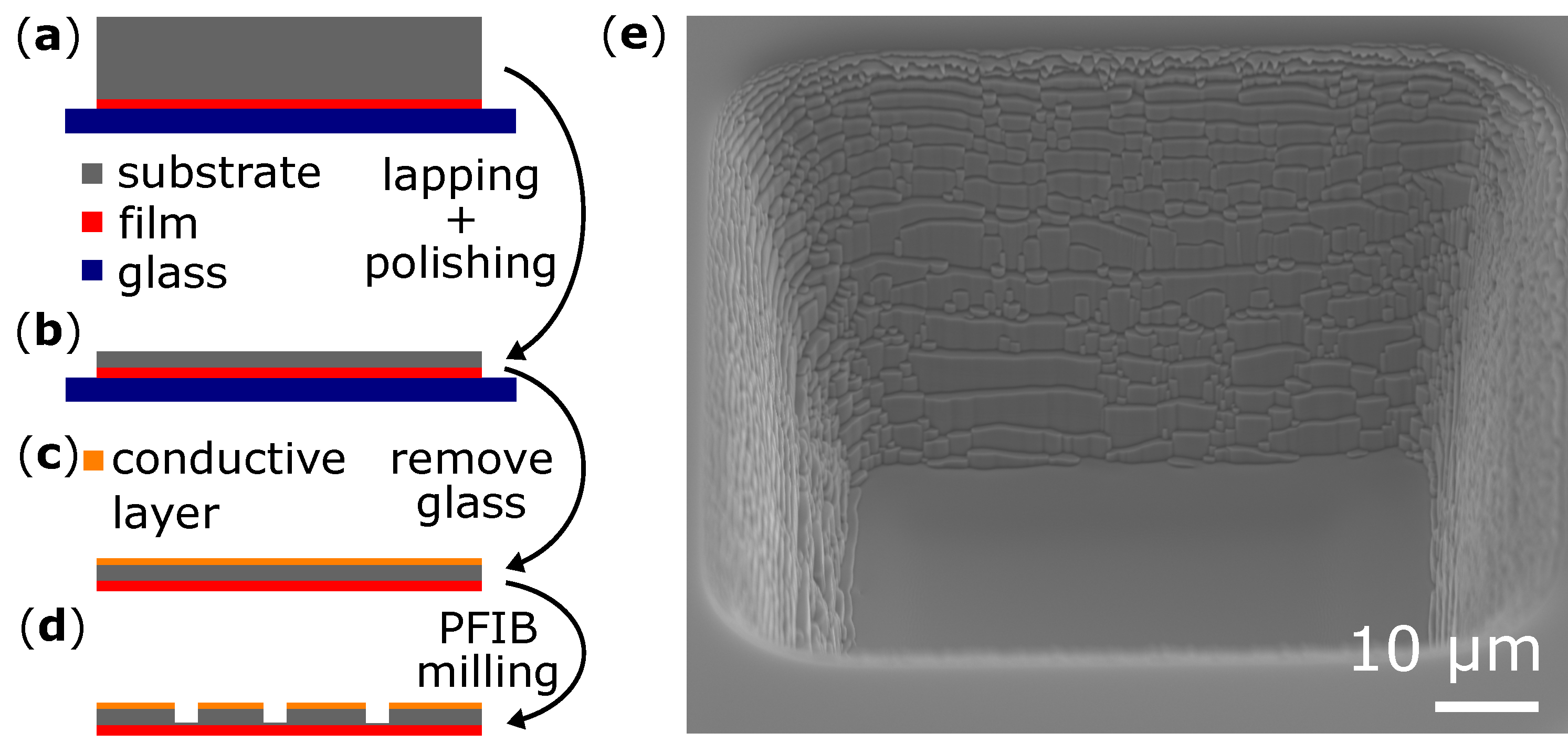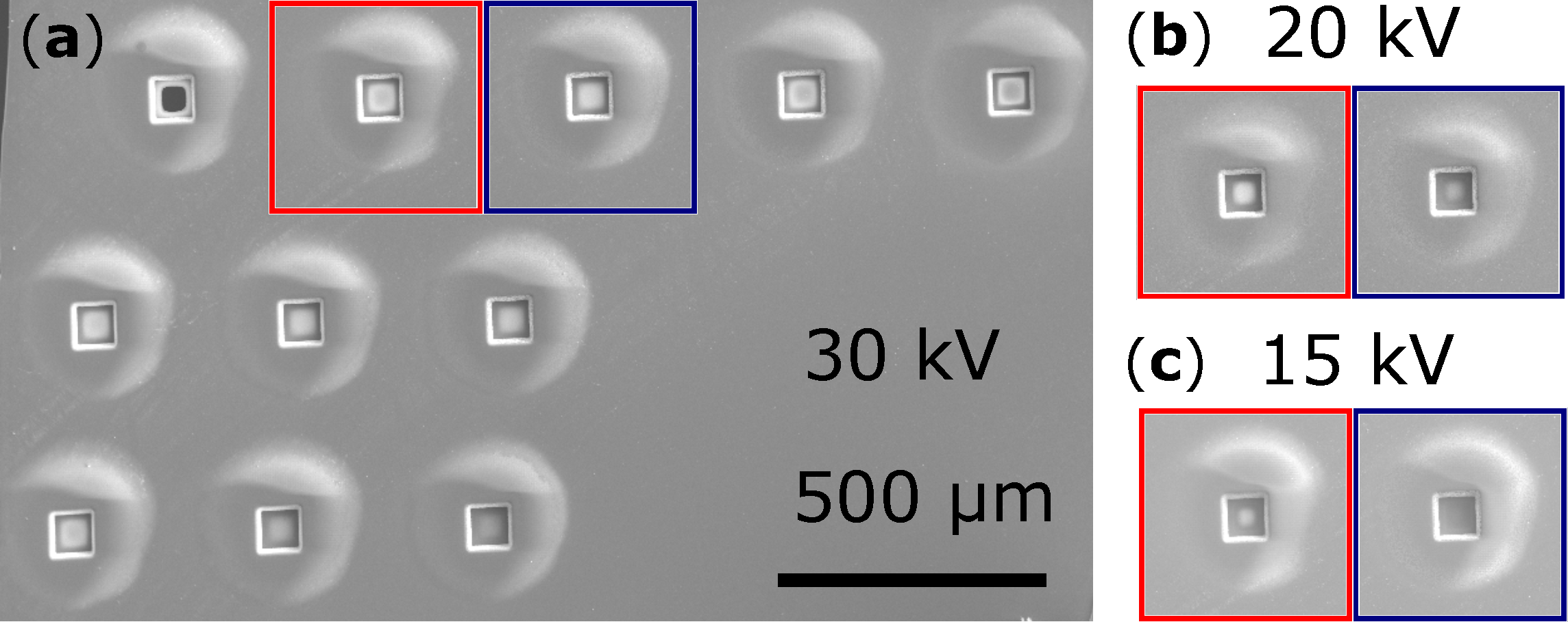Xenon Plasma Focused Ion Beam Milling for Obtaining Soft X-ray Transparent Samples
Abstract
1. Introduction
2. Materials and Methods
3. Results and Discussion
4. Conclusions
Supplementary Materials
Author Contributions
Funding
Data Availability Statement
Acknowledgments
Conflicts of Interest
References
- Willmott, P. Introduction to Synchrotron Radiation: Techniques and Applications; John Wiley & Sons: Chichester, UK, 2019; Volume 2. [Google Scholar]
- Als-Nielsen, J.; McMorrow, D. Imaging, in Elements of Modern X-ray Physics; Wiley: New York, NY, USA, 2011; pp. 305–342. [Google Scholar]
- Henke, B.L.; Gullikson, E.M.; Davis, J.C. X-Ray Interactions: Photoabsorption, Scattering, Transmission, and Reflection at E = 50–30,000 eV, Z = 1–92. At. Data Nucl. Data Tables 1993, 54, 181–342. [Google Scholar] [CrossRef]
- Baldrati, L.; Schneider, C.; Niizeki, T.; Ramos, R.; Cramer, J.; Ross, A.; Saitoh, E.; Kläui, M. Spin transport in multilayer systems with fully epitaxial NiO thin films. Phys. Rev. B 2018, 98, 014409. [Google Scholar] [CrossRef]
- Wadley, P.; Howells, B.; Železný, J.; Andrews, C.; Hills, V.; Campion, R.P.; Novák, V.; Olejník, K.; Maccherozzi, F.; Dhesi, S.S.; et al. Electrical switching of an antiferromagnet. Science 2016, 351, 587–590. [Google Scholar] [CrossRef] [PubMed]
- Pohl, U.W. Epitaxy of Semiconductors: Introduction to Physical Principles; Springer: Berlin/Heidelberg, Germany, 2013. [Google Scholar]
- Pesquera, D.; Herranz, G.; Barla, A.; Pellegrin, E.; Bondino, F.; Magnano, E.; Sánchez, F.; Fontcuberta, J. Surface symmetry-breaking and strain effects on orbital occupancy in transition metal perovskite epitaxial films. Nat. Commun. 2012, 3, 1189. [Google Scholar] [CrossRef] [PubMed]
- Ohtomo, A.; Hwang, H.Y. A high-mobility electron gas at the LaAlO3/SrTiO3 heterointerface. Nat. Cell Biol. 2004, 427, 423–426. [Google Scholar] [CrossRef] [PubMed]
- Seidel, H.; Csepregi, L.; Heuberger, A.; Baumgärtel, H. Anisotropic Etching of Crystalline Silicon in Alkaline Solutions: I. Orientation Dependence and Behavior of Passivation Layers. J. Electrochem. Soc. 1990, 137, 3612–3626. [Google Scholar] [CrossRef]
- Gomes, W.P. Wet Etching of III–V Semiconductors. In Handbook of Advanced Electronic and Photonic Materials and Devices; Nalwa, H.S., Ed.; Academic Press: San Diego, CA, USA, 2001; pp. 221–256. [Google Scholar]
- Förster, J.; Wintz, S.; Bailey, J.; Finizio, S.; Josten, E.; Dubs, C.; Bozhko, D.A.; Stoll, H.; Dieterle, G.; Träger, N.; et al. Nanoscale X-ray imaging of spin dynamics in yttrium iron garnet. J. Appl. Phys. 2019, 126, 173909. [Google Scholar] [CrossRef]
- Digernes, E.; Leliaert, J.; Weigand, M.; Folven, E.; Van Waeyenberge, B. Direct observation of temperature dependent vortex dynamics in a La0.7Sr0.3MnO3 micromagnet. Phys. Rev. Res. 2020, 2, 043429. [Google Scholar] [CrossRef]
- Fohler, M.; Frömmel, S.; Schneider, M.; Pfau, B.; Günther, C.M.; Hennecke, M.; Guehrs, E.; Shemilt, L.; Mishra, D.; Berger, D.; et al. A general approach to obtain soft x-ray transparency for thin films grown on bulk substrates. Rev. Sci. Instrum. 2017, 88, 103701. [Google Scholar] [CrossRef] [PubMed]
- Förster, J.; Gräfe, J.; Bailey, J.; Finizio, S.; Träger, N.; Groß, F.; Mayr, S.; Stoll, H.; Dubs, C.; Surzhenko, O.; et al. Direct observation of coherent magnons with suboptical wavelengths in a single-crystalline ferrimagnetic insulator. Phys. Rev. B 2019, 100, 214416. [Google Scholar] [CrossRef]
- Simmendinger, J.; Ruoss, S.; Stahl, C.; Weigand, M.; Gräfe, J.; Schütz, G.; Albrecht, J. Transmission x-ray microscopy at low temperatures: Irregular supercurrent flow at small length scales. Phys. Rev. B 2018, 97, 134515. [Google Scholar] [CrossRef]
- Baumgaertl, K.; Gräfe, J.; Che, P.; Mucchietto, A.; Förster, J.; Träger, N.; Bechtel, M.; Weigand, M.; Schütz, G.; Grundler, D. Nanoimaging of Ultrashort Magnon Emission by Ferromagnetic Grating Couplers at GHz Frequencies. Nano Lett. 2020, 20, 7281–7286. [Google Scholar] [CrossRef] [PubMed]
- Büttner, F.; Mawass, M.A.; Bauer, J.; Rosenberg, E.; Caretta, L.; Avci, C.O.; Gräfe, J.; Finizio, S.; Vaz, C.A.F.; Novakovic, N.; et al. Thermal nucleation and high-resolution imaging of submicrometer magnetic bubbles in thin thulium iron garnet films with perpendicular anisotropy. Phys. Rev. Mater. 2020, 4, 011401. [Google Scholar] [CrossRef]
- Träger, N.; Groß, F.; Förster, J.; Baumgaertl, K.; Stoll, H.; Weigand, M.; Schütz, G.; Grundler, D.; Gräfe, J. Single shot acquisition of spatially resolved spin wave dispersion relations using X-ray microscopy. Sci. Rep. 2020, 10, 18146. [Google Scholar] [CrossRef] [PubMed]
- Burnett, T.; Kelley, R.; Winiarski, B.; Contreras, L.; Daly, M.; Gholinia, A.; Burke, M.; Withers, P. Large volume serial section tomography by Xe Plasma FIB dual beam microscopy. Ultramicroscopy 2016, 161, 119–129. [Google Scholar] [CrossRef] [PubMed]
- Raabe, J.; Tzvetkov, G.; Flechsig, U.; Böge, M.; Jaggi, A.; Sarafimov, B.; Vernooij, M.G.C.; Huthwelker, T.; Ade, H.; Kilcoyne, D.; et al. PolLux: A new facility for soft x-ray spectromicroscopy at the Swiss Light Source. Rev. Sci. Instrum. 2008, 79, 113704. [Google Scholar] [CrossRef] [PubMed]
- Bouguer, P. Essai d’Optique sur la Gradation de la Lumière. J. Röntgen Soc. 1922, 18, 93. [Google Scholar] [CrossRef]
- Lambert, J.H. Photometria, Sive de Mensura et Gradibus Luminis, Colorum et Umbrae; Sumptibus Vidae Eberhardi Klett: Augsburg, Germany, 1760. [Google Scholar]
- Beer, A. Bestimmung der Absorption des rothen Lichts in farbigen Flüssigkeiten. Ann. Phys. Chem. 1852, 86, 78–88. [Google Scholar] [CrossRef]
- X-Ray Interactions with Matter [Internet]. Available online: https://henke.lbl.gov/optical_constants/ (accessed on 23 April 2021).
- Ziegler, J.F.; Ziegler, M.; Biersack, J. SRIM—The stopping and range of ions in matter (2010). Nucl. Instrum. Methods Phys. Res. Sect. B Beam Interact. Mater. At. 2010, 268, 1818–1823. [Google Scholar] [CrossRef]



Publisher’s Note: MDPI stays neutral with regard to jurisdictional claims in published maps and institutional affiliations. |
© 2021 by the authors. Licensee MDPI, Basel, Switzerland. This article is an open access article distributed under the terms and conditions of the Creative Commons Attribution (CC BY) license (https://creativecommons.org/licenses/by/4.0/).
Share and Cite
Mayr, S.; Finizio, S.; Reuteler, J.; Stutz, S.; Dubs, C.; Weigand, M.; Hrabec, A.; Raabe, J.; Wintz, S. Xenon Plasma Focused Ion Beam Milling for Obtaining Soft X-ray Transparent Samples. Crystals 2021, 11, 546. https://doi.org/10.3390/cryst11050546
Mayr S, Finizio S, Reuteler J, Stutz S, Dubs C, Weigand M, Hrabec A, Raabe J, Wintz S. Xenon Plasma Focused Ion Beam Milling for Obtaining Soft X-ray Transparent Samples. Crystals. 2021; 11(5):546. https://doi.org/10.3390/cryst11050546
Chicago/Turabian StyleMayr, Sina, Simone Finizio, Joakim Reuteler, Stefan Stutz, Carsten Dubs, Markus Weigand, Aleš Hrabec, Jörg Raabe, and Sebastian Wintz. 2021. "Xenon Plasma Focused Ion Beam Milling for Obtaining Soft X-ray Transparent Samples" Crystals 11, no. 5: 546. https://doi.org/10.3390/cryst11050546
APA StyleMayr, S., Finizio, S., Reuteler, J., Stutz, S., Dubs, C., Weigand, M., Hrabec, A., Raabe, J., & Wintz, S. (2021). Xenon Plasma Focused Ion Beam Milling for Obtaining Soft X-ray Transparent Samples. Crystals, 11(5), 546. https://doi.org/10.3390/cryst11050546






